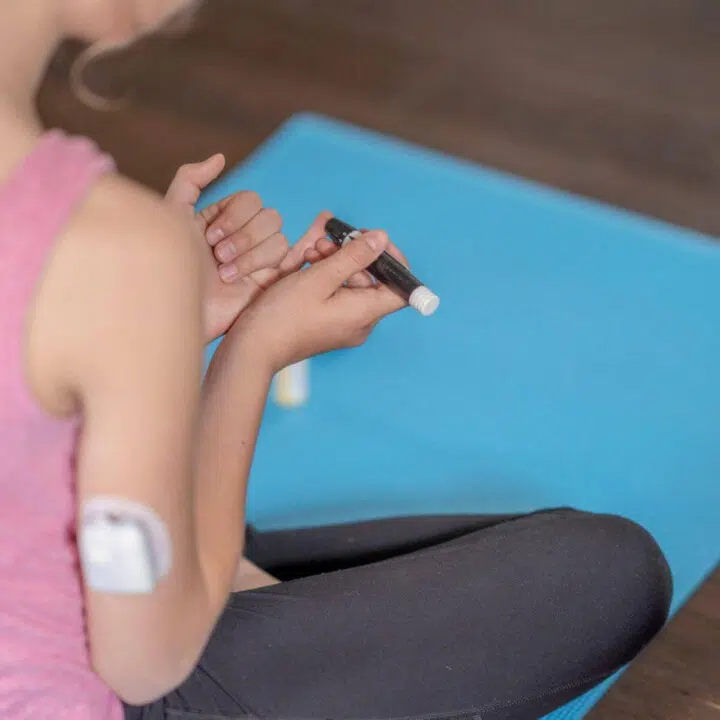We all know we should exercise for better health, but did you know that exercise also has an impact on our glucose and blood sugar levels? Discover how exercise lowers blood sugar with some proven lifestyle strategies. Better blood sugar management is not simply for those who are diabetic or pre-diabetic. Everyone can benefit by understanding why exercise to lower blood sugar is important!

Table of Contents
💪 Exercise and Blood Sugar: How Physical Activity Impacts Glucose Levels
Everyday, millions of us around the globe carve out time for exercise, recognizing its myriad of benefits for our physical and mental well-being. Yet, amidst the sweat and determination of your workouts, have you ever paused to ponder what it might be doing to your blood sugar levels?
⁉️ Why Exercise To Lower Blood Sugar Is Important?
The truth is, few relationships are as crucial as that between exercise and blood sugar regulation. The way physical activity impacts glucose levels can significantly influence our overall health and well-being. Understanding this connection is not just about managing diabetes, it's about unlocking the potential for a healthier lifestyle for everyone. This is why understanding why exercise to lower blood sugar is important.
🍭 The Immediate Effects of Exercise on Blood Sugar
As soon as you lace up your sneakers and hit the pavement or step onto the treadmill, your body begins a remarkable series of reactions that directly influence your blood sugar levels.
One of the most notable immediate effects of exercise is the heightened uptake of glucose by your muscles. When you engage in physical activity, your muscles require more energy to function, prompting them to absorb glucose from the bloodstream at an accelerated rate. This rapid uptake helps reduce blood sugar levels, effectively clearing excess glucose from circulation.
GLUCOSE GATEKEEPER
Furthermore, exercise plays a pivotal role in enhancing insulin sensitivity, particularly during and after physical activity. Insulin, often described as the body's "glucose gatekeeper," facilitates the movement of glucose from the bloodstream into cells, where it can be utilized for energy.
Regular exercise improves insulin sensitivity, making cells more responsive to the hormone's signals, and enabling efficient glucose uptake. This heightened sensitivity persists even after the workout session, contributing to more stable blood sugar levels over time.
However, the impact of exercise on blood sugar levels is not uniform across all types and intensities of physical activity. Different activities elicit varying responses in glucose metabolism.
For instance, aerobic exercises like running, cycling, or swimming typically lead to more significant reductions in blood sugar levels due to their sustained intensity and prolonged duration.
On the other hand, high-intensity interval training (HIIT) may cause temporary spikes in blood sugar levels during intense intervals, but can lead to more substantial reductions post-exercise.
Interestingly, timing your exercise session strategically in relation to meals can also influence your body's response to blood sugar fluctuations. Engaging in physical activity shortly after a meal can enhance glucose uptake by muscles, effectively utilizing the incoming nutrients for energy and preventing postprandial spikes in blood sugar levels.
Similarly, exercising before a meal can help prime your body for efficient glucose utilization, potentially mitigating the impact of carbohydrate intake on blood sugar levels.
🏋️♀️ Long-Term Benefits of Exercise on Blood Sugar Regulation
While the immediate effects of exercise on blood sugar levels are undeniably important, the true impact of physical activity unfolds over the long term, yielding many profound benefits for blood sugar regulation and overall metabolic health.
Regular exercise, when integrated consistently into your lifestyle, can lead to significant improvements in insulin sensitivity and glucose metabolism. With each workout session, your body becomes more adept at utilizing insulin efficiently, allowing better control over blood sugar levels.
Over time, this cumulative effect translates into a reduced risk of insulin resistance, a hallmark of conditions like type 2 diabetes.
Central to the long-term benefits of exercise on blood sugar regulation is its profound influence on muscle mass. Skeletal muscle serves as a primary reservoir for glucose uptake during exercise, helping clear excess glucose from the bloodstream and maintain stable blood sugar levels.
Through regular physical activity, you can not only preserve existing muscle mass, but also promote muscle growth, further enhancing your body's capacity for glucose disposal. This increase in muscle mass contributes to improved blood sugar control and reduced insulin resistance, creating a positive feedback loop that reinforces metabolic health.
Exercise also emerges as a potent preventive measure against type 2 diabetes and metabolic syndrome, conditions characterized by dysregulated blood sugar levels and impaired insulin function. By incorporating regular physical activity into your routine, you can mitigate key risk factors associated with these metabolic disorders, such as obesity, sedentary behavior, and poor dietary habits.
Exercise helps address these risk factors by promoting weight loss, reducing visceral fat accumulation, and enhancing insulin sensitivity, thereby lowering your susceptibility to developing diabetes or metabolic syndrome.
🧡 Building Muscle for Better Blood Sugar Management
Are you ready to begin to understand how exercise lowers blood sugar? Continue reading to further educate yourself.
When it comes to blood sugar regulation, the role of muscle mass cannot be overstated. Muscle tissue serves as a dynamic reservoir for glucose uptake, even at rest. Unlike other tissues in the body, muscles possess insulin-independent mechanisms for absorbing glucose, allowing them to effectively utilize this essential fuel source.
As you build and maintain muscle mass through regular strength training, your muscles become more efficient at extracting glucose from the bloodstream, helping stabilize blood sugar levels and reduce insulin resistance.
Moreover, the relationship between muscle tissue and glucose uptake extends beyond the duration of your workouts. Even during periods of rest, well-conditioned muscles continue to exhibit heightened glucose metabolism, contributing to more stable blood sugar levels throughout the day.
This sustained effect underscores the importance of incorporating strength training exercises into your fitness routine to reap the long-term benefits for blood sugar management.
To harness the blood sugar-regulating potential of muscle-building activities, consider incorporating the following strategies into your balanced fitness regimen.
💁♀️ Top 4 Exercise Strategies For Blood Sugar Regulation
- Prioritize compound movements (think squats, deadlifts, etc).
- Gradually increase the intensity and resistance of your strength training workouts over time.
- Establish a regular schedule for strength training sessions.
- Balance strength with cardiovascular exercise.

💚 Exercise Strategies for Blood Sugar Control
For individuals with diabetes or prediabetes, integrating exercise into your daily routine can be a powerful tool for managing blood sugar levels and promoting overall health. By following these practical strategies, you can harness the benefits of physical activity to optimize your blood sugar control and enhance your well-being.
Embrace Variety
Incorporate various exercises into your routine to target different muscle groups and stimulate fitness. Include aerobic activities, such as walking, cycling, or swimming. In addition, strength training exercises build muscle mass and enhance glucose uptake. Variety not only keeps your workouts engaging, but also ensures comprehensive fitness benefits.
Monitor Blood Sugar Levels
Before engaging in exercise, monitor your blood sugar levels to establish a baseline and identify potential risks. If your blood sugar levels are too high or too low, adjust your exercise intensity or duration accordingly, and consider consuming a small carbohydrate-containing snack if needed to prevent hypoglycemia.
Listen to Your Body
Pay attention to how your body responds to exercise, and adjust your routine as needed. If you experience symptoms of low blood sugar, such as dizziness, sweating, or confusion, stop exercising immediately and consume a fast-acting carbohydrate source, such as fruit juice or glucose tablets, to raise your blood sugar levels.
🥗 Lifestyle Factors to Enhance the Blood Sugar Benefits of Exercise
While exercise plays a pivotal role in blood sugar regulation and overall health, complementary lifestyle factors can further enhance its effectiveness. Let's explore other ways how exercise lowers blood sugar level spikes.
Nutrition
Aim to consume a balanced diet rich in whole grains, lean proteins, healthy fats, and plenty of fruits and vegetables. Prioritize complex carbohydrates that provide sustained energy, and consider timing your meals and snacks to support your exercise routine.
Hydration
Adequate hydration is crucial for maintaining optimal physical performance and supporting blood sugar control during exercise. Drink water before, during, and after your workouts to stay hydrated and replace fluids lost through sweat.
Rest and Recovery
Aim for 7-9 hours of quality sleep each night to support recovery processes and optimize hormone regulation, including insulin sensitivity. Incorporate rest days into your exercise routine to allow your muscles to repair and rebuild, reducing the risk of overtraining and injury.
Stress Management
Incorporate stress-reducing activities into your daily routine, such as mindfulness meditation, deep breathing exercises, yoga, or spending time in nature. By managing stress effectively, you can support healthy blood sugar regulation and enhance the positive effects of physical activity on your overall health.
🩺 Metabolic Conditions That Benefit Through Regular Exercise
Regular exercise is a cornerstone of blood sugar management and overall health, offering numerous benefits for both physical and mental well-being. By incorporating physical exercise activity into your daily routine, you can improve glucose control, lower blood sugar spikes, enhance insulin sensitivity, and reduce the risk of chronic metabolic conditions.
We encourage you to take proactive steps toward a healthier lifestyle by embracing regular exercise and prioritizing your well-being. Whether you're looking to manage diabetes, prevent metabolic disorders, or simply enhance your overall health, physical activity holds the key to unlocking your full potential.
Ready to take the next step toward better blood sugar control and overall well-being? Explore strategies and extra support on your health and fitness journey. Sign up for a nutrition program today.
🗣️ So, Let's Discuss How Exercise Lowers Blood Sugar
Did the connection between exercise and a decrease in blood sugar spikes? Share your experiences in the comments below?
You can also connect with me @EatYourNutrition on Instagram. I love seeing your photos. #EatYourNutrition #LauraVillanueva

📧 Need Help With Sustainable Weight Loss ?
Now that you know how exercise lowers blood sugar, it's time to take some action. So, if you need further assistance with your symptoms, don't hesitate to contact me. Let's work together to embark on a journey towards a healthier, vibrant life. Contact me.
⏭️ ADDITIONAL RESOURCES
Also, for further reading and guidance on how hormonal regulation of glucose works within our body, consider exploring the following resources.
Want a list of foods that can help your body realign with your hormones? Download my free guide, Eat Your Way to Homone Health.
- Get the 7-Day Healthy Eating Meal Plan. Are you ready to reset your health, feel energized, and enjoy delicious, balanced meals without the stress of dieting? This meal plan is designed to help you get back on track with simple, nutrient-packed recipes that support your energy, mood, gut health, and metabolism.
- Support - Join A Fresh Start Healthy Weight Loss Program. It's a 6-week nutrition, health & wellness program for sustainable weight loss. Feel at home in your own body. It's not about perfection. It's about comfort, clarity, and honoring yourself with intention.
📚 References
- Buresh R. Exercise and glucose control. J Sports Med Phys Fitness. 2014 Aug;54(4):373-82. PMID: 25034542.
- Holten MK, Zacho M, Gaster M, Juel C, Wojtaszewski JF, Dela F. Strength training increases insulin-mediated glucose uptake, GLUT4 content, and insulin signaling in skeletal muscle in patients with type 2 diabetes. Diabetes. 2004 Feb;53(2):294-305. doi: 10.2337/diabetes.53.2.294. PMID: 14747278.
📧 Share This Article!
If you found this helpful, share it with a friend who might need some inspiration! Let's build a community of health-conscious individuals, one habit at a time.


















Comments
No Comments